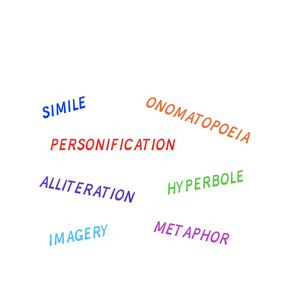



8,000 schools use Gynzy
92,000 teachers use Gynzy
1,600,000 students use Gynzy
General
In this lesson, students will review several types of figurative language: simile, metaphor, imagery, personification, hyperbole, onomatopoeia, and alliteration. The different types of figurative language are defined with examples. Throughout the lesson, students will read numerous sentences and passages, and even two poems ⏤ one by Emily Dickinson and one by Mary E. Wilkins Freeman.
Standards
CCSS.ELA-Literacy.RL.5.4
CCSS.ELA-Literacy.L.5.5
CCSS.ELA-Literacy.L.5.5a
CCSS.ELA-Literacy.RL.6.4
CCSS.ELA-Literacy.L.6.5
CCSS.ELA-Literacy.L.6.5a
CCSS.ELA-Literacy.RL.7.4
CCSS.ELA-Literacy.L.7.5
CCSS.ELA-Literacy.RL.8.4
CCSS.ELA-Literacy.L.8.5
Learning Objective
Students will be able to recognize and define different types of figurative language.
Introduction
The lesson begins with a descriptive writing exercise in which students observe an image and write a few sentences describing what they see, trying to be as descriptive as possible. After learning the different types of figurative language, students will identify the type of figurative language used in a passage.
Instruction
Students will drag words into a passage to create alliteration then write their own hyperbole. Students will then read a sentence and drag an "S" for simile and "M" for metaphor, and identify which two items are being compared in the sentences. They will also come up with their own human characteristics to create personification. Students will then be presented with scenarios like, "Bacon on a hot frying pan," and they will come up with an appropriate sound word. Finally, they will read from Emily Dickinson's "A Bird Came Down the Walk" and Mary E. Wilkins Freeman's "The Snowflake Tree," identifying the figurative language used in the poems.
Quiz
Students are given ten questions to answer, in which they are asked to determine what type of figurative language is used, to answer read a sentence and decide on the type of figurative language being used.
Closing
Students spin a wheel. Each letter represents a type of figurative language. Students must write an example of whatever type they land on.
Teaching tips
Have your students identify the imagery used in the two poems of the lesson. Ask, "Which sense does this appeal to?"
The online teaching platform for interactive whiteboards and displays in schools
Save time building lessons
Manage the classroom more efficiently
Increase student engagement
Discover more!
About Gynzy
Gynzy is an online teaching platform for interactive whiteboards and displays in schools.
With a focus on elementary education, Gynzy’s Whiteboard, digital tools, and activities make it easy for teachers to save time building lessons, increase student engagement, and make classroom management more efficient.



